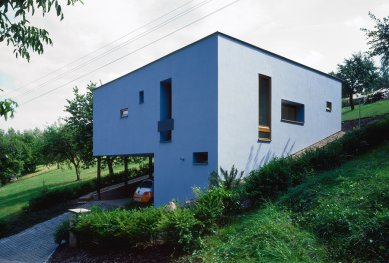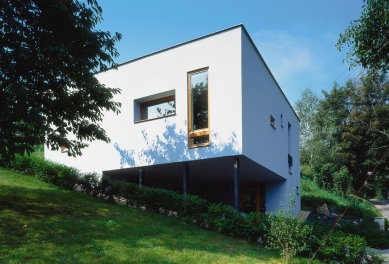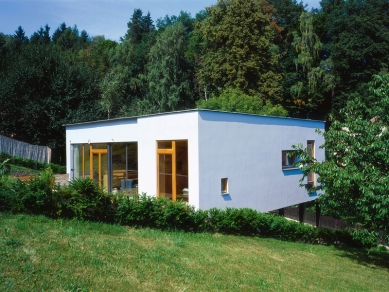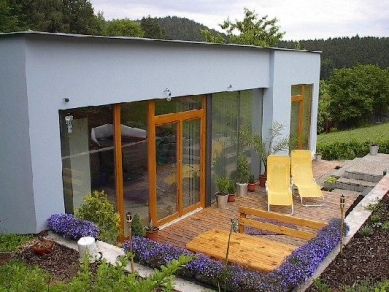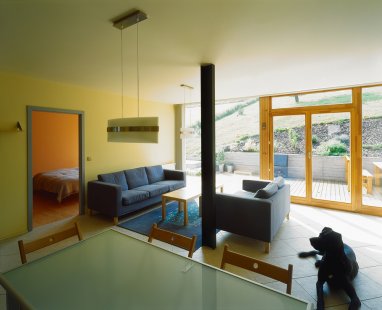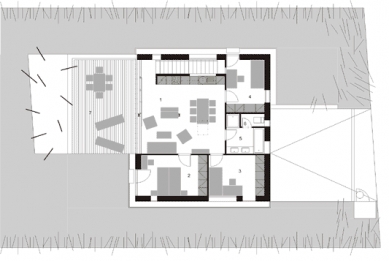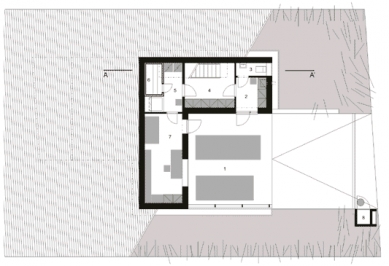
Family house in Dřevíč

The House That Is Just Landing
The designed house is situated in the suburbs of a small town, in Dřevíč near Hronov at the border with Poland. The process of preparation and implementation of the construction for a young investor with limited financial means brought about a special willingness from the builder for contemporary architectural concepts and also quite a challenging permitting process.
Before starting the design work on the house, the author showed the investor the now legendary book by F. Kobosil and S. Koláček, "Family Houses Abroad." The realization of family homes from the sixties captured the investor's interest so much that he began to demand a solution that would be contemporary and not in the spirit of the generally widespread historicizing convention. The book, perhaps filed away in some libraries or even weeded out, facilitated better communication between the author and the investor and primarily laid the foundation for the investor's trust in the architect. It was possible to start searching for a path to a result that presents contemporary young people and their lifestyle: simple, straightforward, and dynamic. The type of investor is apparent from the size parameters of the building. They are determined by the financial possibilities of minimal savings from building savings.
The environment of the construction does not offer many stimuli in its layout. Nowadays, there is no need to look for stimuli in the surroundings of the construction. After all, can some really be found here in Dřevíč? The steep path to the construction site could just as well lead to a mountain hut. The surrounding dispersed development has no own character. The sum of it all offers an ideal opportunity to remain oneself. Both for the architect, the builder, and the house itself.
The house is dramatically set into the slope of a small valley. Considering its size, the degree of aggressiveness of its impact on the environment is appropriate. The construction merely claims an adequate right to its natural autonomy. The choice of the first floor for the carport is a fundamental element of the solution. At first glance, the incoming person has the feeling that the building is floating above the terrain or, rather even better, as if it is landing on the slope. Perhaps the feeling of a possible collision between the "landing" building and the slope best reflects the current atmosphere of the time. It is not very considerate or humble. But that is precisely why it makes no sense to live in illusions that the present is different—caring, romantic, and "contextual," and perhaps even creating and expanding them.
The entrance to the house is on the ground floor, from the carport area. The living rooms are on the upper floor. They consist of a living space with an incorporated staircase and a kitchen cube, as well as a bedroom, a room, and a bathroom. The living room is completely open to the outdoor terrace carved into the slope. The terrace is truly the airport of the building. The place of contact between the house and the terrain.
David Chmelař designed the house to be striking and dramatic. He gave it simple rules. A rectangular floor plan. He included a simple system for the windows. The ratios of the total window openings on the northern, eastern, and western façades correspond to the sizes of the openings on the southern façade. An axis runs through the ground plan of the house. With its rectangular foundational layout and the choice of mass, it challenges excessive feelings of stability. Its dramatic shell can provide plenty of order in the uncertainty of every age.
There are a lot of people who want to have a house that they have seen somewhere. They probably feel that they are getting closer to something associated with a widely spread ideal and simultaneously avoiding the risk of bearing the investor's responsibility for associating with less common things. It is relatively easy to turn on the television and watch the main character in their villa in a multi-part series and believe that by building a replica of this building the viewer will become a part of the hero's success. The house in Dřevíč does not belong to a similar group with its investor. Searching for one's own real values is significantly more challenging. However, it can save everyone from losing a number of illusions.
The designed house is situated in the suburbs of a small town, in Dřevíč near Hronov at the border with Poland. The process of preparation and implementation of the construction for a young investor with limited financial means brought about a special willingness from the builder for contemporary architectural concepts and also quite a challenging permitting process.
Before starting the design work on the house, the author showed the investor the now legendary book by F. Kobosil and S. Koláček, "Family Houses Abroad." The realization of family homes from the sixties captured the investor's interest so much that he began to demand a solution that would be contemporary and not in the spirit of the generally widespread historicizing convention. The book, perhaps filed away in some libraries or even weeded out, facilitated better communication between the author and the investor and primarily laid the foundation for the investor's trust in the architect. It was possible to start searching for a path to a result that presents contemporary young people and their lifestyle: simple, straightforward, and dynamic. The type of investor is apparent from the size parameters of the building. They are determined by the financial possibilities of minimal savings from building savings.
The environment of the construction does not offer many stimuli in its layout. Nowadays, there is no need to look for stimuli in the surroundings of the construction. After all, can some really be found here in Dřevíč? The steep path to the construction site could just as well lead to a mountain hut. The surrounding dispersed development has no own character. The sum of it all offers an ideal opportunity to remain oneself. Both for the architect, the builder, and the house itself.
The house is dramatically set into the slope of a small valley. Considering its size, the degree of aggressiveness of its impact on the environment is appropriate. The construction merely claims an adequate right to its natural autonomy. The choice of the first floor for the carport is a fundamental element of the solution. At first glance, the incoming person has the feeling that the building is floating above the terrain or, rather even better, as if it is landing on the slope. Perhaps the feeling of a possible collision between the "landing" building and the slope best reflects the current atmosphere of the time. It is not very considerate or humble. But that is precisely why it makes no sense to live in illusions that the present is different—caring, romantic, and "contextual," and perhaps even creating and expanding them.
The entrance to the house is on the ground floor, from the carport area. The living rooms are on the upper floor. They consist of a living space with an incorporated staircase and a kitchen cube, as well as a bedroom, a room, and a bathroom. The living room is completely open to the outdoor terrace carved into the slope. The terrace is truly the airport of the building. The place of contact between the house and the terrain.
David Chmelař designed the house to be striking and dramatic. He gave it simple rules. A rectangular floor plan. He included a simple system for the windows. The ratios of the total window openings on the northern, eastern, and western façades correspond to the sizes of the openings on the southern façade. An axis runs through the ground plan of the house. With its rectangular foundational layout and the choice of mass, it challenges excessive feelings of stability. Its dramatic shell can provide plenty of order in the uncertainty of every age.
There are a lot of people who want to have a house that they have seen somewhere. They probably feel that they are getting closer to something associated with a widely spread ideal and simultaneously avoiding the risk of bearing the investor's responsibility for associating with less common things. It is relatively easy to turn on the television and watch the main character in their villa in a multi-part series and believe that by building a replica of this building the viewer will become a part of the hero's success. The house in Dřevíč does not belong to a similar group with its investor. Searching for one's own real values is significantly more challenging. However, it can save everyone from losing a number of illusions.
Alexandr Skalický, see Stavba 3/2000
The English translation is powered by AI tool. Switch to Czech to view the original text source.
0 comments
add comment


